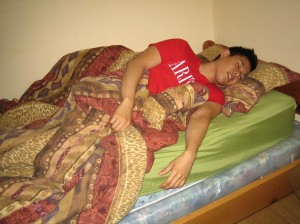Narcolepsy is temporary paralysis that happens during rapid eye movement (REM) sleep the period of sleep in which dreaming is happening. Another symptom of narcolepsy is a chronic sleep disorder that is defined by morning sleepiness and abrupt sleepiness. People with this kind of disorder have difficulty staying awake for extended periods of time, regardless of the circumstances. This disorder can cause serious disruptions in the daily routine. Narcolepsy is a condition where there is no cure, but some medications and changes in lifestyle can help minimize the symptoms and support from families, friends, employer and teachers can help a child or person suffering from narcolepsy help in coping with the problem.
Symptoms
The symptoms of narcolepsy begin between the ages 10 and 25. They worsen for about a year and can continue for life. People suffering from narcolepsy just fall asleep without warning, like a person just fall asleep while talking, he or she sleeps for a few minutes or an hour before waking and feels refreshed, but fall asleep again.

A person may have a decreasing alertness throughout the day. Excessive sleepiness is the first symptom that appears and it is the most troublesome, making the person difficult to concentrate and function well. A person suffering from narcolepsy has sudden loss of muscle tone, and this condition is called cataplexy and can cause physical changes, from slurred speech to complete weakness of muscles and last for a few seconds or minutes. Some people suffering from narcolepsy have only one or two episodes of cataplexy a year, while other people have plenty of episodes daily. Not everyone suffering from narcolepsy has cataplexy. Another symptom of narcolepsy is sleep paralysis. They are usually brief and last from one to two minutes, but can be dangerous. The person is aware of the condition but he/she has difficulty recalling what happened. Sleep paralysis mimics hallucinations and are called hypnagogic hallucinations that happens as the person is falling asleep, and hypnopompic hallucination happens upon waking up. People suffering from narcolepsy may have sleep disorder like obstructive sleep apnea, a condition which the breathing starts and stops all through the night and the person is restless while leg syndrome and can even cause insomnia. A person suffering from narcolepsy acts out their dreams at night by swinging their arms or kicking and sometimes screaming.
Treatment and home remedies
- A person should stick to a schedule like going to sleep and waking up at the time of the day, also on weekends.
- Set short naps at systematic intermissions throughout the day. A break of 20 minutes during the day may be stimulating and will minimize sleepiness for one to three hours.
- Avoid using nicotine and alcohol during night time since it can worsen the signs and symptoms.
- Get a moderate and regular exercise at least four to five hours before going to bed and the person feels awake during the day and has a better sleep at night.
If you want to learn more about narcolepsy, all you have to do is to enroll in a first aid course today.
